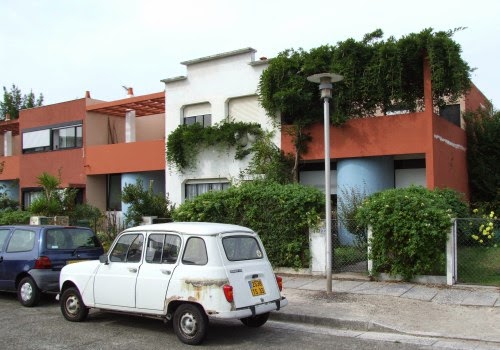“Architecture,” pronounced the famed modern architect Le Corbusier, “is the learned game, correct and magnificent, of forms assembled in the light.”
And what a preposterous statement that is, even coming from this supremely dogmatic thinker. Astonishingly, Le Corbusier’s definition manages to overlook the single operative purpose of every proper work of architecture in history--that of enclosing interior volume, or in plain words, providing shelter. The “learned game” Le Corbusier describes is much more akin to sculpture than to architecture, though no one seemed willing to call the great man’s bluff at the time.
 |
| Pessac worker housing: Le Corbusier putting "function and objects in order." |
If Le Corbusier’s bizarre definition managed to neglect architecture’s central purpose, we shouldn’t be too surprised. Of all the great modernists--and despite his many addled theoretical excursions, he was certainly that--his works have proven the most susceptible to the critical lens of retrospect. He was perhaps the greatest modernist to see architecture as a social tonic, and the architect as a social engineer who should be dispatched to change human behavior rather than accomodate it.
 |
| Pessac today, after being personalized by its owners. |
“To create architecture is to put in order,” Le Corbusier further proclaimed, betraying a notable nonchalance for the human variable. “Put what in order? Function and objects.”
Yet the Corbusian style, with its fastidious oranization and near-supernatural purity of form, proved to be an aesthetic ideal whose underpinnings seldom held up under the messy rigor of real-life use. The wealthy owners of his villas naturally deferred to his aesthetic no matter the cost, but the less heavily vested users of his buildings----the very bourgeoisie he hoped to educate and rescue from their traditional lifestyles--did not always react so favorably. Time after time, Le Corbusier’s public works were famously subverted by their users.
 |
| The Plan Voisin, which proposed razing a large portion of downtown Paris and replacing it with a more orderly grid of highrise buildings. Note the Ile de la Cite at lower right. |
In 1925, he built his first large-scale project at Pessac in France, a pristine and flawlessly proportioned low-cost housing development, only to find its residents chafing under his efforts to put their “function and objects” in order. Over the next forty years, Pessac residents variously grafted on traditional pitched roofs, turned terraces into extra bedrooms, and hung planter boxes from windows, all in an effort to personalize the project’s pointed anonymity.
If Pessac’s shortcomings seem relatively innocuous, though, consider Le Corbusier’s contemporary Plan Voisin, in which he proposed to raze a good portion of Paris and replace it with a phalanx of identical concrete highrises. Nor did this brand of thinking change to any great extent later in his career. His Unite d’Habitation, completed at Marseilles in 1952, once again proffers the ideal of the gridded concrete tower, this time with a purported rooftop “garden” entirely paved over in concrete and relieved only by a number of abstract concrete sculptures. Almost thirty years after Pessac, the architect was still exasperated to find residents outfitting his pristine interiors with wrought-iron chandeliers and Louis XIV furniture.
 |
| Chandigarh, Palace of the Assembly. |
Also begun in 1952 was the crown jewel of Le Corbusier’s career, his complex of government buildings in Chandigarh, India. Here he once again utilized coarsely formed concrete buildings on a monstrous scale, seemingly oblivious to the physical and cultural context. And once again, he played his “learned game...of forms assembled in the light,” while neglecting the human beings whom it was created for.










